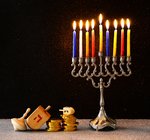 Severna Park
Severna ParkOvercast, 53°
Wind: 9.2 mph, E
 Severna Park
Severna Park


December is about more than just Christmas. Though it doesn’t always fall in December, Hanukkah is also associated with the December holiday season. Kwanzaa, which starts December 26 and ends January 1, is also grouped into the holiday festivities.
Hanukkah
Called the Festival of Lights, Hanukkah is an eight-day celebration. It commemorates when the Jews had only enough oil to keep the Holy Temple’s menorah lit for one day, but it lasted for eight. It’s called the miracle of Hanukkah, which means “dedication” in Hebrew.
Each night of Hanukkah, the Jewish people light one more branch of the menorah, starting on the right side and moving left.
The reason Hanukkah does not always fall in December — or even on the same dates — is because it follows the Jewish calendar, which differs from the 12-month calendar we use.
A traditional treat eaten during Hanukkah is the latke, or potato pancake. Latkes are fried in oil and served with a variety of toppings, including sour cream and applesauce.
Another common treat is Hanukkah gelt, or chocolate coins. This stems from an age-old custom of giving gifts of gelt, or money, to kids during Hanukkah.
This year, Hanukkah runs from December 2-10.
Kwanzaa
Kwanzaa is an African-American and pan-African holiday that celebrates family, community and culture. The seven-day culture festival was created in 1966 by Dr. Maulana Karenga, an Africana studies professor.
There are the Seven Principles of Kwanzaa, which are celebrated throughout the seven days: Umoja, unity; Kujichagulia, self-determination; Ujima, collective work and responsibility; Ujamaa, cooperative economics; Nia, purpose; Kuumba, creativity; and Imani, faith.
In addition to the principles, there are seven symbols of Kwanzaa: Mazao, the crops; Mkeka, the mat; Kinara, the candle holder; Muhindi, the corn; Mishumaa Saba, the seven candles; Kikombe cha Umoja, the unity cup; and Zawadi, the gifts.
Black, red and green represent Kwanzaa: black for the people, red for their struggle, and green for the future and hope that comes from their struggle. On the kinara, one candle is black, three are green and three are red, and each candle represents one of the principles.
The last day of Kwanzaa celebrates the Day of Meditation, during which the African people engage in quiet reflection.
Comments
No comments on this item Please log in to comment by clicking here